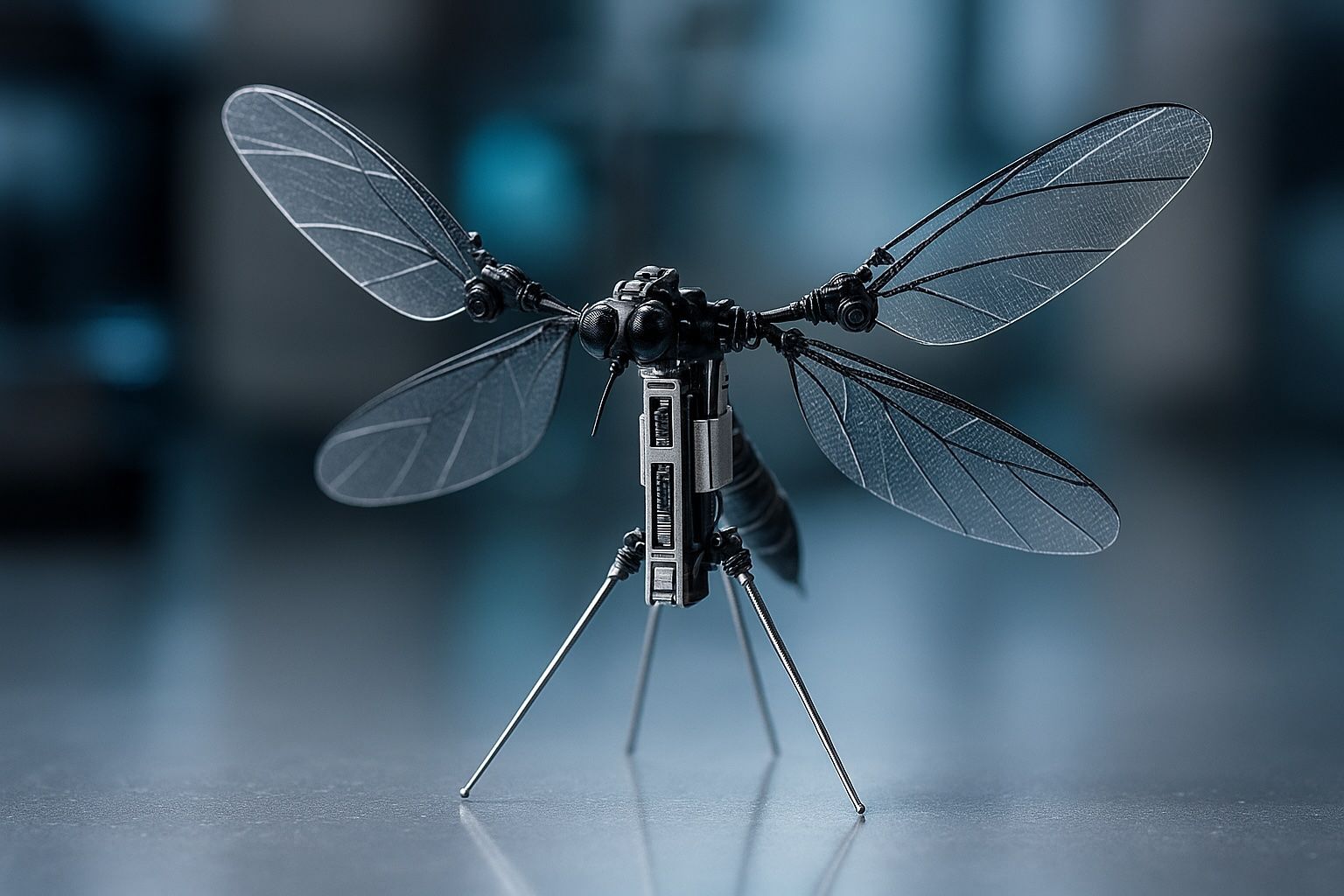- On 20 June 2025 CCTV aired footage from the National University of Defence Technology showing student Liang Hexiang balancing a micro-robot the size of a mosquito between his fingers.
- The insect-sized drone uses flapping leaf-shaped wings and hair-thin legs to hover, perch and crawl inside buildings for information reconnaissance on the battlefield.
- Analysts describe the device as part of China’s PLA modernization drive, pushing covert surveillance to a new extreme.
- Its dimensions are about 1.3 cm long and it weighs less than 0.3 g.
- It has three carbon-fiber legs with a 0.1 mm diameter that double as landing gear and conduction pads, with patents hinting at wall-mounted inductive charging tiles for swarms.
- The drone is smartphone-controlled and is compared to Norway’s palm-sized Black Hornet 4 as a Western analogue.
- Beijing’s drone-mothership concept was showcased at Zhuhai 2024 with the 16-ton Jiu Tian carrier UAV designed to disgorge entire squadrons of micro- and loitering munitions.
- In urban ISR, the drone can perch on window ledges to collect audio in GPS-denied cities.
- PLA concepts envision releasing 20+ drones from a magazine-style launcher to saturate radar and short-range air defenses.
- PLA mass-production goals target a factory line producing 10,000 units per month at under USD 150 per airframe.
1. What Actually Happened?
On 20 June 2025 state broadcaster CCTV aired footage from the National University of Defence Technology (NUDT) showing a student, Liang Hexiang, balancing a micro-robot “the size of a mosquito” between his fingers. NUDT engineers explained that the bionic craft’s flapping leaf-shaped wings and hair-thin legs let it hover, perch and even crawl inside buildings—ideal for “information reconnaissance and special missions on the battlefield.” [1]
A wave of follow-up journalism quickly fleshed out the basic facts:
| Outlet (date) | Key new details | Citation |
|---|---|---|
| Indian Defence Review (23 Jun 2025) | Drone is part of a wider PLA-modernisation drive and takes covert surveillance “to a new extreme.” | [2] |
| Interesting Engineering (21 Jun 2025) | Confirms smartphone control, three “legs” for perching and cites Norway’s palm-sized Black Hornet 4 as a Western analogue. | [3] |
| ZME Science (23 Jun 2025) | Notes the drone can “slip through windows,” warns of “dystopian” potential, and places it in the context of autonomous-weapon debates. | [4] |
| Straight Arrow News(23 Jun 2025) | Provides a capability rundown and compares it to U.S. Air Force and Norwegian micro-UAV programs. | [5] |
| NDTV (22 Jun 2025) | Gives dimensions (~1.3 cm long, <0.3 g) and highlights CCTV footage. | [6] |
| Jerusalem Post (23 Jun 2025) | Repeats size/weight figures and emphasises covert role. | [7] |
2. Inside the Engineering Breakthrough
- Power-to-weight crisis. Batteries, processors and radios must weigh milligrams yet run cameras or sensors long enough to matter on patrol. Engineers say squeezing “sensors, power devices, control circuits and other elements into a very small space” required cross-disciplinary materials science and MEMS research. [8] [9]
- Flapping-wing flight. Mimicking a mosquito’s clap-and-fling vortex yields better lift at insect scale than mini propellers but forces designers to build sub-gram actuators that can beat hundreds of times per second without burning out.
- Perching legs. The three carbon-fiber “legs” (0.1 mm diameter) double as landing gear and charge-conduction pads—NUDT’s patents hint at wall-mounted inductive re-charging tiles for swarms rest-and-relay operations (patent CN117995432-A, 2024).
“We’ve seen an explosion of creativity from the Chinese defence industry.” — Elsa Kania, Center for a New American Security (Jan 2024) [10]
3. Why Beijing Wants Insect Drones
| PLA Objective | How a Mosquito Drone Helps |
|---|---|
| Urban ISR — dense, GPS-challenged cities | Fly down alleyways or HVAC ducts, perch on window ledges for audio collection. |
| Compound entry | Slip through cracks before troops breach, streaming floor-plan video. |
| Swarm saturation | Overwhelm radar and short-range air defences; a single soldier might deploy 20+ bots from a magazine-style launcher. |
| Ethical deniability | Difficult forensic trace; payload could be camera, RF sniffer or micro-explosive. |
NUDT’s reveal dovetails with China’s “drone mothership” strategy: at Zhuhai 2024 the 16-ton “Jiu Tian” carrier UAV debuted, designed to disgorge entire squadrons of micro- and loitering munitions. [11] Military planners envision the mothership orbiting 50 km from target, releasing hundreds of mosquito drones for last-meter sensing or strike.
4. Global Context—The Micro-UAV Arms Race
| Country | Signature program | Status |
|---|---|---|
| Norway / US | Teledyne FLIR Black Hornet 4 (33 g) | 2025 DoD Blue UAS winner; battery & wind hardening upgrades. [12] |
| USAF | Classified insect-scale MAV (RoboBee lineage) | Public demos ended 2021; development continues under AFWERX. [13] |
| Russia | Reliant on imported DJI/Autel quads; no micro flappers yet. Samuel Bendett notes Russia would need Chinese mass production to match swarms. [14] | |
| EU | €45 m EU-SWARM project (Czech/Italian lead) for disaster-response micro-drones. | Prototype hover-perch bots due 2026. |
Defense analyst Timothy Heath says Beijing wants “a military that can employ artificial intelligence, autonomous systems and generally, a lot more unmanned systems” to offset U.S. air superiority. [15]
5. Strategic & Political Fallout
- Regulatory backlash. The U.S. Congress is weighing a ban on new Chinese-made drones over espionage fears, likening them to “spy balloons.” [16]
- Counter-drone R&D. DARPA’s Mosaic Warfare program shifted 2026 funds to “Bio-Mimetic Target Intercept,” seeking RF-agnostic net launchers and AI acoustic detectors.
- Escalation risk. Low-cost lethality could tempt first-use in a Taiwan crisis; mosquito drones could disable radar arrays silently hours before a major strike.
- Norm-setting vacuum. Existing UN CCW discussions focus on lethal autonomy above 25 kg; sub-gram platforms fall outside current draft protocols.
6. Ethical & Privacy Concerns
| Risk | Why It Matters |
|---|---|
| Non-detectability | Civilian spaces (embassies, boardrooms, homes) become vulnerable to surreptitious video or DNA sampling. |
| Attribution gap | After an assassination or sabotage, forensic teams may recover no evidence bigger than a clipped wing. |
| Proliferation | 3-D-printed frames + off-the-shelf MEMS could let non-state actors copy designs within five years. |
| Gene-mod payloads | Bio-engineers have floated insect-borne pathogen delivery; a micro-rotor could do the same, anonymously. |
7. What Happens Next?
- Mass-production proof. PLA doctrine prizes numbers; the key milestone will be a factory line cranking 10,000 units per month with <USD 150 per airframe.
- Swarm-AI trials. Expect naval exercises in the Bohai Gulf pairing “Jiu Tian” motherships with insect drones for ship-deck target recognition by late 2026.
- Counter-drone market boom. Acoustic triangulation startups (e.g., Black Swan Labs, Poland) already demoed 35 kHz insect-drone detectors; NATO SOF are field-testing them 2025-Q4.
- Diplomatic pressure. EU parliamentarians call for an Insect-UAV export-control list at the next Wassenaar Arrangement plenary.
8. Bottom Line
China’s mosquito-sized UAV is more than a clever lab prototype—it is the bellwether of a miniaturised drone era in which silent, cheap and hard-to-trace robots do the dirtiest work of war and espionage. As one PLA engineer put it on CCTV, “If you can’t see it, you can’t shoot it.” [17]
Whether global regulators move faster than the innovators will determine if the technology empowers primarily first responders and farmers—or assassins and invaders.
References
1. www.scmp.com, 2. www.indiandefencereview.com, 3. interestingengineering.com, 4. www.zmescience.com, 5. san.com, 6. www.ndtv.com, 7. www.jpost.com, 8. www.scmp.com, 9. interestingengineering.com, 10. blog.polymernanocentrum.cz, 11. dronexl.co, 12. interestingengineering.com, 13. san.com, 14. x.com, 15. blog.polymernanocentrum.cz, 16. apnews.com, 17. www.scmp.com










